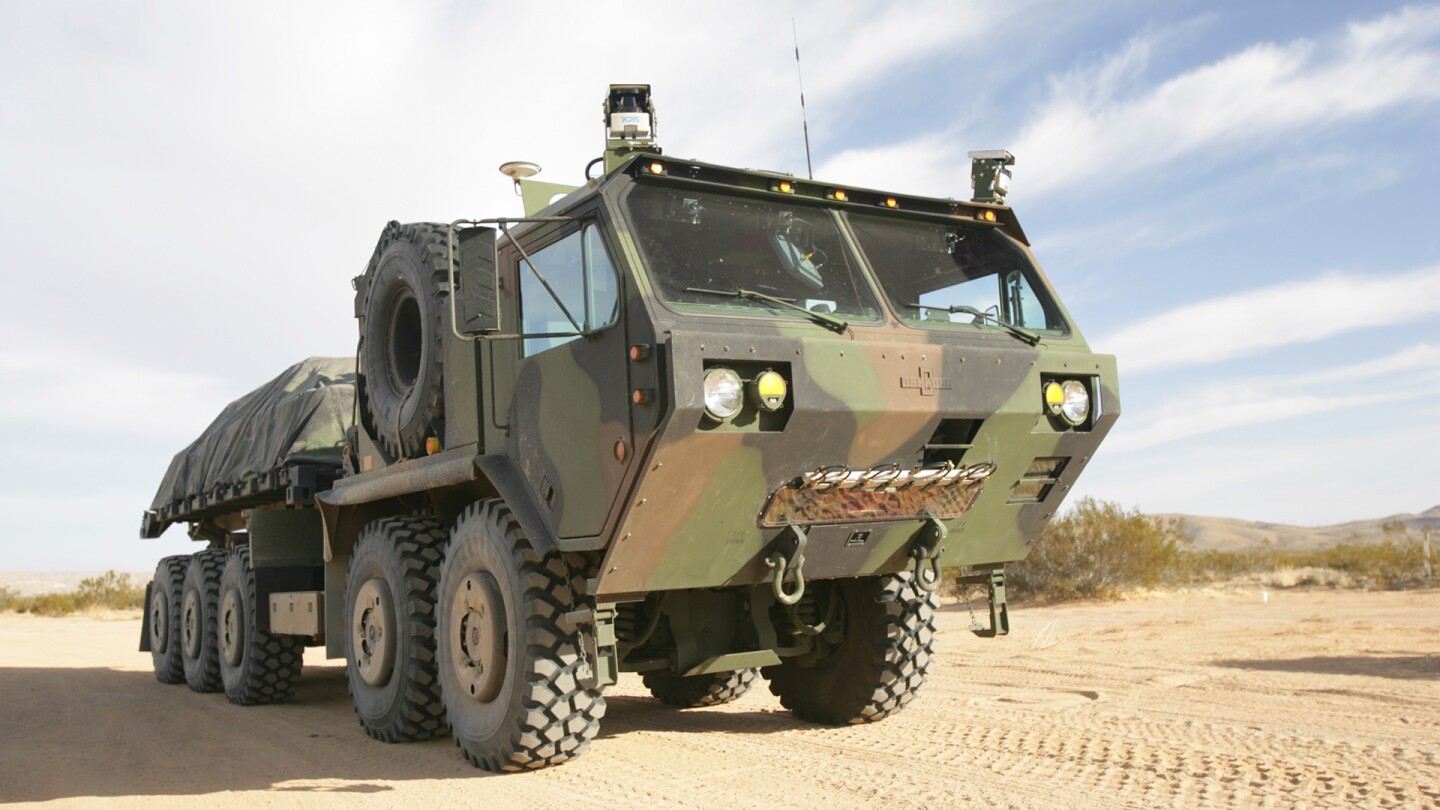It has been an exciting year for hybrid power train development in major racing series, with the teams deciding that KERS will return to Formula One in 2011, the growing success of the Porsche 911 GT3 R Hybrid in the Intercontinental Le Mans Cup and now the news that Oshkosh Corporation will be fielding a 400 bhp hybrid diesel-electric Light Concept Vehicle in the Baja 1000 desert race which begins later this week in Mexico. Perhaps even more interesting than the hybrid powertrain is its TAK-4 suspension which offers 20 inches of independent wheel travel.
The accompanying images are the first available of the Oshkosh LCV which is unquestionably being developed with a view to playing a significant in-theater role for the American military. Oshkosh already has a number of commercially-available semi- and fully-autonomous vehicles and participated in all three of the DARPA Grand Challenges for autonomous vehicles with distinction. It’s hence not surprising that it should be putting some of its more advanced technologies into competition to see how they measure up in the no-compromise world of race engineering.
Just what to expect of the Oshkosh LCV is difficult to predict. It’s Oshkosh ProPulse® diesel-electric powertrain design will obviously deliver excellent fuel economy, but it’s not really been designed for desert racing. The U.S. military uses two sources of power on the battlefield – everything with an internal combustion engine runs on diesel and everything else runs on electricity. This latter category accounts for an increasing percentage of the military’s in-theatre energy requirements, and one of the many advantages of the ProPulse® drivetrain is that it is capable of exporting “significant levels of electrical power”. One day soon, the LCV might well be used as an in-theater, high-speed, autonomous electrical power station.

That's only part of its unique and ingenious design. The ProPulse system also simplifies the transmission of power to the wheels. The diesel engine powers an electric generator, which provides direct power to the wheels, eliminating the torque converter, automatic transmission, transfer case and drive shafts. The system has no batteries, using ultracapacitors for energy storage. A regenerative system uses the traction motors as generators for vehicle braking, storing the energy and then uses it during the next acceleration event, thus reducing wear and tear on the brake system.
That’s not to say that it isn’t suited for desert racing. Diesel power has already been comprehensively shown to have a massive advantage in long distance road racing by the LMP1 cars of Audi and Peugeot where the smooth predictable initial grunt gets it out of turns quicker and the frugal fuel consumption can see it run much longer between stops. The ProPulse system uses less moving parts, and will hence be less prone to breakage – at least on paper. Using intelligent electronic systems to deliver the exact amount of power required at each wheel has long been one of the promises of electric vehicles and the ProPulse looks capable of delivering a competitive advantage in the desert racing conditions of the Baja 1000 mile race. Probably the biggest indication of the potential of the team is the group of drivers it has assembled – all of them are regular finishers and none of them are strangers to the podium at big desert events.
In honesty though, the race participation is all about testing new technologies, and the truly fascinating aspect of the LCV for me is the next-generation TAK-4® independent suspension system. I have been riding off-road racing bikes since a few inches of suspension travel was state-of-the-art, and hence the Oshkosh patented TAK-4® suspension system, which is designed to use up to 20 inches of travel on each wheel, is … astonishing. That’s a lot of suspension travel at race speeds and controlling that much wheel travel at high speeds with obstacles arriving at 90 mph is highly problematic. The press release claim that its speeds may be up to 40% faster than the competition will make it well worth watching.

The extreme wheel travel is clearly being developed so that it can transport goods (and humans), very quickly, over very rough terrain, without damaging its cargo. Military R&D has been delivering breakthrough technology to peacetime society for thousands of years, and it’ll be interesting to see how the TAK-4 suspension copes at racing speeds, given it’s raison d’etre is unquestionably to increase off-road mobility, improve vehicle maneuverability and provide a smoother ride for military purposes. Could the next quantum leap in desert racing be provided by the military?
“Oshkosh engineers are dedicated to producing the most advanced vehicle technologies for a variety of highly-specialized industries,” according to Oshkosh Advanced Products VP Chris Yakes, who is also a member of the Oshkosh Extreme Racing Team which is fielding the two-vehicle team. “In pursuit of next-generation technologies for future fleets, we’ve been testing our concept vehicles in remote locations in the United States, and we are now competing in the Tecate SCORE Baja 1000 – our most intense challenge to date.”
“We’re looking forward to the race and its inherent ability to push our team and the vehicle technologies we’ve developed,” Yakes said. “We expect to learn a lot from this event and will apply those learnings to our ongoing research and development efforts.”









